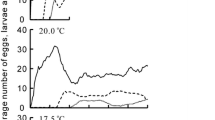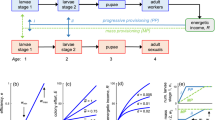Summary
-
1
The presence of a queen in a culture of larvae of two distinct sizes causes the large to receive less and the small more than they would otherwise do. But the competitive relationship persists and is only modified not reversed; nor is food ever perfectly dispersed but small larvae may if queens are present get more than they might expect if it was distributed in the ratio of initial larval weight.
-
2
Autumn queens are unable to suppress large but may be able to assist small larvae.
-
3
These effects are absolute and do not depend on the simultaneous presence of two sizes of larvae.
-
4
Scars due to biting have been found on large but not small larvae in the presence of queens. They are normally associated with a smaller gain in weight though exceptions occur.
-
5
Suppression of growth can be traced back to larvae of 1.0 mg, that is to about the stage when worker ontogenies first deviate from normal queen ones.
-
6
The better dispersion of food when queens are present leads the winter larval population to assume a symmetrical size frequency distribution with, in terms of the annual brood oscillation, an increased amplitude and decreased wavelength.
Résumé
-
1
La présence d'une reine dans un élevage de larves de deux tailles différentes détermine que les plus grandes larves reçoivent moins de nourriture, et les petites plus qu'autrement. Mais le rapport de concurrence persiste—il est seulement modifié et non pas inversé—et la nourriture n'est jamais parfaitement distribuée, mais les petites larves peuvent, si les reines sont là, avoir plus qu'elles n'attendraient, si elle était distribuée dans le rapport du poids initial des larves.
-
2
Les reines automnales sont incapables de supprimer les grandes larves, mais elles peuvent avoir la capacité d'aider les petites.
-
3
Ces résultats sont absolus et ne dépendent pas de la présence simultanée de larves de deux tailles.
-
4
Ces cicatrices dues à des morsures ont été trouvées sur des grandes larves, mais pas sur des petites, en présence de reines. Elles sont normalement associées à une plus petite augmentation de poids, bien que des exceptions aient lieu.
-
5
Un arrêt de croissance peut être constaté chez des larves de 1.0 mg, l'étape où le développement des ouvrières se différencie de celui des reines normales.
-
6
La meilleure distribution de nourriture quand les reines sont présentes provoque chez la population larvale hivernale, une distribution symétrique de fréquence de grandeur avec, en ce qui concerne l'oscillation annuelle du couvain, une amplitude augmentée et une onde de longueur diminuée.
Zusammenfassung
-
1
Die Gegenwart einer Königin in einer Larvenkultur zweier abgesonderter Gröben verursacht die grössere weniger und die kleinere mehr aufzunehmen als es sonst der Fall wäre. Aber die konkurrenzfähige Verbindung beharrt, sie ist nur geändert, nicht ungestossen; noch ist die Nahrung stets volkommen versprengt, aber kleine Larven können, wenn Königinnen zugegen sind mehr bekommen, als sie erwarten, würde es im Verhältnis des anfänglichen Larvengewichts verteilt werden.
-
2
Herbstköniginnen sind unfähig Grosse zu hemmen, aber sie sind im Stande kleinen Larven beizustehen.
-
3
Diese Effekte sind sicher und hängen nicht von der gleichzeitigen Gegenwart zweier Larvengrössen ab.
-
4
Narben, als Folge von Bissen sind an gro en, aber nicht an kleinen Larven gefunden worden wenn Königinnen anwesend waren. Sie sind normalerweise mit einem kleinen Gewinn an Gewicht vereint, obgleich Ausnahmen vorkommen.
-
5
Unterdrückung des Wachstums kann bis zur Larve von 1.0 mg nachgeforscht werden, das ist ungefähr bis zu dem Stadium, in dem Arbeiter «ontogenies» zuerst von donnormalen Königinnen abweichen.
-
6
Die bessere Zerstreuung von Nahrung in Gegenwart der Königinnen führt die Winterlarvenbevölkerung dazu gleichmassige Grössen anzunehmen, durch die Häufigkeit der Verteilung der jährlichen Brutschwingung entstehen ein zunehmender Umfang und verminderte Wellenlänge.
Similar content being viewed by others
References
1950.Brian (M. V.). — The stable winter population structure in species ofMyrmica (J. Anim. Ecol.,19, p. 119–123).—Brian (M. V.) 1957a. Food distribution and larval size in cultures of the antMyrmica rubra L. (Physiol. Comp. et Oecol.,4, p. 329–345).—Brian (M. V.). 1957b. Serial organisation of brood inMyrmica (Insectes sociaux,4, p. 191–210).—Brian (M. V.) 1957c. The growth and development of colonies of the antMyrmica (Insectes Sociaux,4, p. 177–190).—Brian (M. V.) 1958. The evolution of queen control in the social Hymenoptera. (Proc. 10th Int. Congr. Ent.,2, p. 497–502).
1960.Brian (M. V.) andCarr (C. A. H.). — The influence of the queen on brood rearing in ants of the genusMyrmica (J. Ins. Physiol.,5, p. 81–94).
1962.Brian (M. V.) andHibble (J.). — 9-Oxodec-trans-2-enoic acid andMyrmica queen extracts tested for influence on brood inMyrmica (J. Ins. Physiol., in press).
1956.Butler (C. G.). — Some recent advances in apicultural research (Ann. Rev. Ent.,1, p. 281–298).
1952.Schneirla (T. C.) andBrown (R. Z.). — Sexual broods and the production of young queens in two species of army ants (Zoologica,37, p. 5–32).
1961.Schneirla (T. C.). — The behaviour and biology of certain nearctic Doryline ants: sexual broods and colony division inNeivamyrmex nigrescens. (Z. f. Tierpsychologie,18, p. 1–32).
Additional information
The Nature Conservancy, Furzebrook Research Station.
Rights and permissions
About this article
Cite this article
Brian, M.V., Hibble, J. Larval size and the influence of the queen on growth inMyrmica . Ins. Soc 10, 71–81 (1963). https://doi.org/10.1007/BF02223523
Issue Date:
DOI: https://doi.org/10.1007/BF02223523




